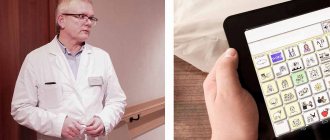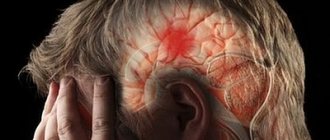Classes with a speech therapist to help quickly restore speech after a stroke
Many people are interested in the question: “Speech therapist-aphasiologist - who is this, what does this specialist do and how effective are his methods of therapy?” In medical practice, this specialist conducts speech therapy classes that allow adults to restore speech after severe cerebrovascular accidents, neuroinfectious diseases, benign or malignant neoplasms.
The effectiveness of treatment depends on four main factors:
- efficiency of the treatment started: the faster a full-fledged complex therapy is carried out, the less time will be needed for rehabilitation;
- affected speech center;
- type of aphasia;
- the extensive area of necrosis of some areas of the brain (if the nerve cells that are responsible for speech function are affected, a severe form of aphasia will occur).
Restoring speech with aphasia can take from 2-3 days to 1-3 years. If the patient puts in a lot of effort, there is a high probability of speech restoration. A neurologist, speech therapist-aphasiologist, and rehabilitologist will help you fight the disease.
Logorhythmic activities are games that allow you to re-develop motor skills and pronunciation. Restorative techniques include gaming, movement and musical games. Tasks are given by a specialist on cards; they correspond to the age and level of development of the patient.
Games for logorhythmic exercises with patients with aphasia are considered effective and are used by many domestic and foreign doctors. You need to practice with game cards every day to use your memory and speed up your full recovery.
The patient can perform some exercises with family and friends. For example, they may begin the sentence “Today is very good for...”, and the patient needs to continue with “years.” In the same way, a familiar song is sung, the patient joins in and sings along. In this way, memory is trained and associations arise.
Drawing up a speech therapy program
The most important period for correcting the speech apparatus after an attack is the first 6-12 months.
At the beginning of the lesson, the speech therapist conducts speech disinhibition. He finds an emotional component that forces the patient to independently enter into dialogue if the patient reacts to the doctor’s speech. Speech therapy material for classes is selected based on the results of tests.
You should not change the doctor in the process of rehabilitation work if he copes with his task, since during the sessions he will be able to get to know the person better and find an individual approach. With each lesson you need to increase the load.
The specialist draws up a plan of activities that will not put too much strain on the patient. It is mandatory to perform special exercises (reading tongue twisters, drawing, facial and speech therapy massage). Classes with a speech therapist for people after a stroke can be held at home. The correction is carried out in conjunction with the use of medications, physiotherapy and other manipulations prescribed by the doctor.
Classes with a speech therapist after an attack are very effective, especially if elements of music therapy are used. Corrective techniques are based on the patient performing simple exercises that help him quickly restore speech function.
Speech therapy exercises to restore speech after a stroke at home
Let us now consider what methods a specialist can offer to restore a patient’s speech, and how they should be applied.
Articulation and breathing exercises
First, the person is asked to simply breathe, then, as he exhales, pronounce certain consonant sounds, one sound per exhalation. After this, while exhaling, all these sounds are pronounced in a row. There are no more than four of them. Sounds can be pronounced while exhaling, also with the chin raised.
Articulation gymnastics after a stroke
It includes exercises for the tongue, lips, voice, and facial muscles.
Exercises for the tongue and soft palate
- Stick your tongue out of your mouth and hold it there for a few seconds.
- Pull it down again and bend it up, hold it for a while.
- Pull it down and direct it first to the right corner of the mouth, then to the left.
- Move the tip of your tongue back and forth across the roof of your mouth.
- Direct your tongue to the right and left cheek.
- Click your tongue, first once, then twice, then three.
- Relax your tongue and, moving it back and forth, lightly bite with your teeth.
- Lick your lips first in one direction, then in the other.
Lip exercises
- Move your lips forward.
- Make a smile with your mouth closed.
- Bare your teeth and raise your upper lip, hold this for a couple of seconds.
- Puff out your cheeks and pump the air from side to side, rolling the air around your mouth.
- Relax your lips and blow through the gap in them.
Voice exercises
Speech gymnastics is performed for ischemic or hemorrhagic stroke.
- We pronounce all the vowel sounds separately, first long, then short, while exhaling. After this, as you exhale, we pronounce all the sounds in a row.
- We say the sound Y only articulatory, without sound, and feel the tension under the chin.
- We pronounce all the vowel sounds in a row, flowing into one another, alternately emphasizing different sounds.
- We pronounce consonant sounds, first unvoiced, separately, then one after another on one exhalation. After this, we pronounce voiced sounds in the same way. We add consonant sounds with vowels into certain syllables, while alternating paired unvoiced and voiced consonants.
All combinations of sounds, their permutations and combinations are determined by the speech therapist.
Tongue twister exercises after a stroke
First, we ask the patient to finish the tongue twister he knows, gradually increasing the number of words he says. If possible, we bring the exercise to perfection.
Exercises for facial muscles
- Raise your eyebrows, lower them, frown, relax.
- Open your mouth wide, try to stretch it, then relax it.
- Smile without opening your mouth.
- Inflate and deflate your cheeks.
- Pull your lips out as if for a kiss.
- Extend your tongue as far as possible in different directions from your mouth.
- Move your lower jaw carefully, first to the left, then to the right, then in a circle.
Speech therapy massage after stroke
After completing a set of exercises, it is necessary to apply a facial massage to each area of the face.
It is important that massage movements are selected only by a specialist. Some areas of the face will need to be relaxed, while others will need to be toned. If you approach this on your own, you can cause irreparable harm.
In addition to massaging the facial muscles directly, they massage the tongue, lips, inner surface of the cheeks, ears, scalp, and hands. All this relieves muscle stiffness and thus liberates speech.
Forms of speech disorders after stroke
The most common disorders are aphasia and dysarthria. Aphasia
In aphasia, speech suffers due to damage to the speech centers in the brain. Aphasia can be complete (when there is no speech at all) or partial. In the first days after a stroke, there is often a complete lack of speech. The situation usually improves over time. There are several forms of aphasia:
- Dynamic. With dynamic aphasia, it is impossible to formulate a statement - not only external, but also internal speech is impaired.
- Motor. The patient is able to pronounce individual sounds and understand speech, but cannot pronounce words and sentences.
- Sensorna. With sensory aphasia, the situation is exactly the opposite - the ability to speak is combined with the inability to understand speech (in mild cases - only complex and long sentences).
- Amnestic. With amnestic aphasia, a person recognizes objects, knows why they are needed, but forgets their names.
- Semantic. Semantic aphasia is difficulty in perceiving complex grammatical and case structures. Simple sentences are perceived normally.
Dysarthria
Disorders with dysarthria are associated with impaired mobility of the organs of articulation - the tongue, palate, lips. With dysarthria, it is possible to distinguish speech by ear, but the patient’s speech itself is slurred, sluggish and dull, expressed in separate sounds or absent altogether.
Speech impairment due to stroke
Stroke can be hemorrhagic or ischemic. With a hemorrhagic stroke, too much blood flows to the brain, and arteries may rupture, but with an ischemic stroke, on the contrary, not enough blood flows to the brain.
Hemorrhagic stroke is less common, but causes more serious consequences for the patient. But in both cases, the areas of the brain responsible for speech may be damaged in a person.
- Exercises after a stroke at home for recovery
If speech fails, then the disturbances occurred in the left hemisphere of the brain. With such a stroke, the right side is paralyzed and there is no speech.
Strokes with paralysis on the right side occur more often than on the left. And this is better for the patient, since in this case it is easier to make a diagnosis, since speech disorders are always manifested.
Such disorders are called aphasia. In this case, disturbances can occur in different parts of the brain. Depending on this, the consequences may be different. How to restore speech after an ischemic or hemorrhagic stroke?
Let's look at the types of aphasia and their consequences:
- Amnestic . A person can communicate, but periodically forgets the names of the objects he is talking about.
- Semantic . In this case, you need to talk to the patient exclusively in simple sentences; he simply will not understand complex ones.
- Sensory . A complex type of aphasia in which the patient does not understand speech at all. For him it comes down to a set of sounds. At the same time, he practically cannot understand the meaning of what was said.
- Motor . A person understands everything, but cannot say anything coherently, confuses sounds and words, or gets stuck on one sound combination.
- Total . The patient does not understand anything, does not recognize anyone, cannot say anything. Most often, this phase occurs immediately after a stroke. After some time, it can turn into motor.
No one can give a 100% guarantee that the patient will be able to speak at all. But if you act quickly, correctly, follow all the recommendations of specialists, create an atmosphere of patience, love and care around a sick relative, support him as much as possible in his desire to recover, then he has a much better chance of quickly recovering his speech loss.
Simple speech problems can be solved in 2–6 months with special regular training and exercises. If the degree of violation is greater, then more time will be required.
Sometimes this can last up to several years. A forecast of 5-10 years is considered a period after which changes for the better are hardly possible. However, miracles of recovery happen, but they most often lie in the realm of intangible reality.
People say, “Houses and family walls heal.” This relates to the question of how relatives of a stroke patient should behave. The first questions they ask the doctor are: “Is speech restored after a stroke? Is it even possible to restore speech after a stroke? How long does it take for speech to be restored after a stroke? Relatives can be understood. But a lot depends on their behavior, on their actions.
Here are the usual recommendations from doctors to the patient’s relatives:
- The patient must feel that his family needs him, that he is valuable to her, that his relatives believe in him, love him, sincerely wish for his recovery and do not doubt it at all. In this case, he will have additional motivation to get back on his feet as quickly as possible. This means there will be energy for this.
- You need to constantly talk with the patient and in his presence. Then he will feel involved in the family. But the most important thing: if the topic is important to him, he will try to talk.
- It’s good if his favorite music, the songs he used to sing, are played in the house. The inner desire to sing along can well stimulate the awakening of his speech impulses.
- But it is better to remove excess noise, variety and volume of sounds so as not to overload the patient. You need to talk to him quietly, calmly, without explosive emotions. Surround him with your kindness. At the same time, there is no need to emphasize every time that he is terminally ill.
- Relatives need to have maximum patience, since they are the ones who must become constant assistants for the patient when performing the exercises that the speech therapist will show. And under no circumstances should you react with irritation if you can’t do the exercise.







